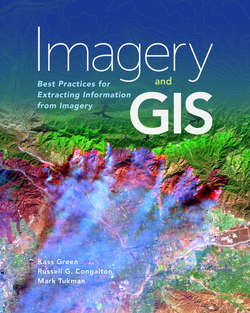Читать книгу Imagery and GIS - Kass Green - Страница 31
На сайте Литреса книга снята с продажи.
The Electromagnetic Spectrum
ОглавлениеMost remote sensing imaging surfaces work by responding to photons of electromagnetic energy. Electromagnetic energy is caused by the phenomenon of photons freeing electrons from atoms. Termed the photoelectric effect, it was first conceptualized by Albert Einstein, earning him the Nobel Prize in physics in 1921.
Electromagnetic energy occurs in many forms, including gamma rays, x-rays, ultraviolet radiation, visible light, infrared radiation, microwaves, and radio waves. It is characterized by three important variables: 1) speed, 2) wavelength, and 3) frequency The speed of electromagnetic energy is a constant of 186,000 miles/second, or 3 × 108 meters/second, which is the speed of light. Wavelength is the distance between the same two points on consecutive waves and is commonly depicted as the distance from the peak of one wave to the peak of the next, as shown in figure 3.3. Frequency is the number of wavelengths per unit time.
Figure 3.3. Diagram demonstrating the concepts of electromagnetic wavelength and frequency
The relationship between wavelength, wave speed, and frequency is expressed as
Because electromagnetic energy travels at the constant speed of light, when wavelengths increase, frequencies decrease, and vice-versa (i.e., they are inversely proportional to each other). Photons with shorter wavelengths carry more energy than those with longer wavelengths. Remote sensing systems capture electromagnetic energy emitted or reflected from objects above 0 degrees Kelvin (absolute 0).
Electromagnetic energy is typically expressed as either wavelengths or frequencies. For most remote sensing applications, it is expressed in wavelengths. Some electrical engineering applications such as robotics and artificial intelligence express it in frequencies. The entire range of electromagnetic wavelengths or frequencies is called the electromagnetic spectrum and is shown in figure 3.4.
Figure 3.4. The electromagnetic spectrum
The most significant difference between our eyeballs and digital cameras is how the imaging surfaces react to the energy of photons. As shown in figure 3.4, the retinas in human eyes sense only the limited visible light portion of the electromagnetic spectrum. While able to capture more of the spectrum than human eyes, film is limited to wavelengths from 0.3 to 0.9 micrometers (i.e., the ultraviolet, visible, and near infrared). CCD or CMOS arrays in digital sensors are sensitive to electromagnetic wavelengths from 0.2 to 1400 micrometers. Because remote sensors extend our ability to measure more portions of the electromagnetic spectrum than our eyes can sense, remote sensors extend our ability to “see.”
